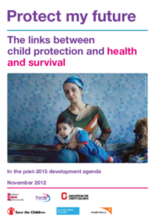This inter-agency paper was written by Family for Every Child, Better Care Network, Consortium for Street Children, Save the Children, SOS Children’s Villages, and World Vision, for submission to the United Nations consultation: ‘Health in the Post-2015 Development Agenda'. By examining the links between child protection and health, this paper responds to the call for papers which address ‘cross-sectoral action for health.’
The paper demonstrates the interdependence between goals on health and child survival and the protection and care of children. Maternal health and HIV have major impacts on child protection outcomes. The loss of protection from a caregiver makes children more vulnerable to abuse and exploitation. The continuing rates of maternal mortality leave children growing up without a mother. Whilst these boys and girls are often cared for by fathers or extended family, they can be both less likely to survive and more vulnerable to child protection risks. The vast majority of children outside of parental care in the developing world are looked after by their families, most commonly grandparents. Despite their best efforts, a lack of external support means that older caregivers are not always able to provide the best care their grandchildren need to survive and thrive (EveryChild and HelpAge International 2012). The paper asserts that improving the quality of alternative care will make MDG targets on infant mortality and nutrition more achievable. Many children placed in alternative care experience such poor quality of care that it threatens their survival. There are growing numbers of children living institutions where large numbers of children often co-exist in over-crowded and unhealthy situations, and neglect and physical abuse are common (EveryChild 2011; Williamson and Greenberg 2010).
There is also much evidence to suggest that children without adequate care and protection are not receiving sufficient or appropriate health care and support: children living or working on the streets are discriminated against health care services, children living with employers are often denied access to health care, or children with HIV in residential care do not always get adequate health care and psychosocial support. Not only do health care providers and systems fail to meet the needs of children without adequate care and protection, but also misguided actions may increase separation. For instance, health care professionals sometimes encourage new parents from disadvantaged backgrounds or with children with disabilities to place their babies in care of the state in the belief that they will be better looked after. This inevitably leads to the unnecessary institutionalization of children (UNICEF 2010).
In order to best address both child health and protection, it is therefore imperative for future health and survival goals to include targets, reflecting equity in access to health care especially for the children without adequate care and protection, and a post-MDG framework that encapsulates prevention of violence, exploitation, abuse, and neglect of children as well as provision for a safe family environment.
©Family for Every Child, Better Care Network, Consortium for Street Children, Save the Children, SOS Children's Villages, World Vision

